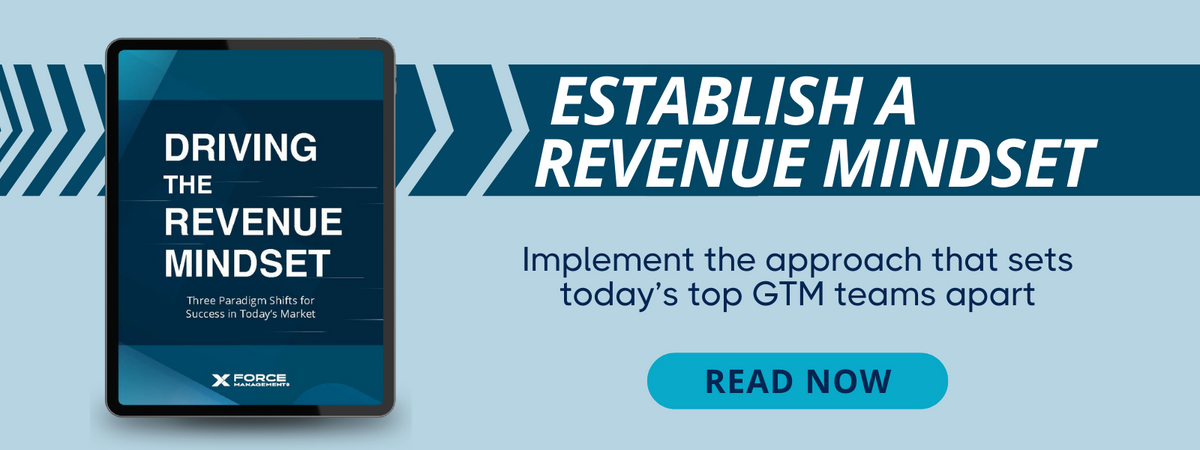
Start the Year Strong: Resolutions for Each Member of Your Revenue Team
Categories: Sales Transformation | Sales Leadership | Company Alignment
There’s no doubt that the way sales organizations and their customers interact has shifted in the past few years. From a new remote-first approach to rapid digital technology advancement, the customer journey is new and requires active participation from more than just your sales team. The companies that succeed in 2024 will be those who adopt a cross-functional revenue mindset, equipping every customer-facing role to articulate and negotiate on the value of their solution.
With that in mind, here are some focus areas for each team in your customer-facing revenue organization that will help improve cross-functional alignment and execution of your revenue strategy throughout the year.
Executive Leadership Team
Support cross-functional collaboration and alignment that enables a better customer journey.
Today’s top sales organizations succeed by creating a unified go-to-market motion that aligns the entire commercial organization. The first step to enhancing interdepartmental collaboration is to align cross-functional leaders. Ensure the entire executive team agrees on your solution value and differentiation and how it is communicated to customers. A good test is to have your executive team answer these four essential questions:
- What problems do we solve for customers?
- How specifically do we solve these problems?
- How do we do it differently than the competition?
- What is our proof?
Once your executive team is aligned, then you can strategize on how to align your teams to execute on delivering these four answers. Clearly define the components of a great deal from your organization’s perspective and outline how each department contributes, codifying key handoff points and responsibilities for each role.
Sales Team
Develop a customer-first sales approach that integrates cross-functional partners to ensure consistency across all touchpoints and interactions.
Although the sales process is expanding, Sales is still the pivotal role to the customer conversation. Therefore, it’s important for Sales to be intentional about identifying opportunities for cross-functional involvement and maintaining communication with the entire revenue team. For example, if a rep uncovers a potential risk concern around implementation with a buying party, they could get Customer Success involved to outline their process and help with risk reduction. As a lead moves into and out of the Sales pipeline, reps should communicate the key value points and requirements with other teams to maintain consistency in messaging.
To facilitate cross-team collaboration, it will be critical for reps to execute deep and meaningful discovery within each client account. Sellers are more than likely dealing with multiple stakeholders in every deal - as they uncover specific pain points, business outcomes, and solution requirements for each party, they should seek out cross-functional support to address and satisfy those expectations. By fundamentally understanding the needs of the buyer and internal parties early in the deal, reps are better equipped to start negotiating early and often, allowing them to influence solution requirements. This approach will help the entire revenue team consistently drive unanimous support and urgency for your solution with buyers.
Marketing Team
Shape the business conversation by generating content and messaging that communicates business value at every stage of the customer interaction.
To facilitate the value-driven customer conversation, it’s critical that Marketing create content that communicates key customer outcomes your solution provides from the first interaction - taking into account that the first interaction can come from many touchpoints in the digital landscape. Today’s customers gather information from online sources before ever interacting directly with a salesperson, and most continue to do independent research throughout their journey.
Marketing should align content to a clear ideal customer profile and its desired positive business outcomes to attract qualified leads and help move active opportunities through the pipeline. In the cross-functional revenue mindset, Marketing helps support sellers and internal buyer champions with content that justifies the value of the solution. Consider what the ideal customer profile looks like at the level of each decision-maker, and generate alignment on the value that must be communicated to the economic buyer, technical buyer, and implementation owner. Consider how Marketing can support the journey for each of these stakeholders.
Customer Success
Focus on capturing and delivering value throughout the customer journey as a continuous motion, not just sale and delivery.
Traditionally, there is a “hand-off” between Sales and Customer Success teams once deal contracts are signed. In our experience, companies win more and have more satisfied customers when these two teams work collaboratively. In companies with a revenue mindset, CS teams participate in negotiation and risk reduction at key points in the sales process, providing important credibility around the implementation process.
Once implementation begins, CS will be better equipped to ensure alignment between customer expectations and the delivery. Because they were involved in the sales process, they understand the exact value the customer expects and can continue to connect features to business outcomes throughout training to improve adoption. This customer value focus can enable Customer Success to take advantage of cross-sell and upsell opportunities because of their unique understanding of customer utilization and ROI.
Administrative Teams
Create opportunities to delight and increase value for customers while maintaining maximum internal value from every deal.
The key to preserving value for both your organization and the buyer is to ensure early alignment on what administrative needs are on both sides. Legal and Finance teams should clearly define what constitutes a great deal from a logistical perspective and ensure early communication of these parameters.
In order to drive a mutually beneficial process, it’s also important that administrative teams understand how the customer’s expected value relates to final deal terms. Ensure that contract teams communicate with sales at key points in the customer journey to set expectations and maintain consistency in messaging even through the final stages of the deal.
Admin teams can also be a powerful asset for your negotiation strategy. Consider where these players can draft in to ensure buyer requirements and risk concerns are addressed to help drive unanimous support for your solution from a multi-stakeholder buying committee.
Activate Your Revenue Mindset
Today’s top revenue organizations have cracked the code on a cross-functional go-to-market motion that meets customer needs at every touchpoint. We developed a resource to help leaders tap into that mindset, making it accessible and actionable for every member of the revenue team.
Download the leadership guide to get strategies for driving the revenue mindset within your organization.


